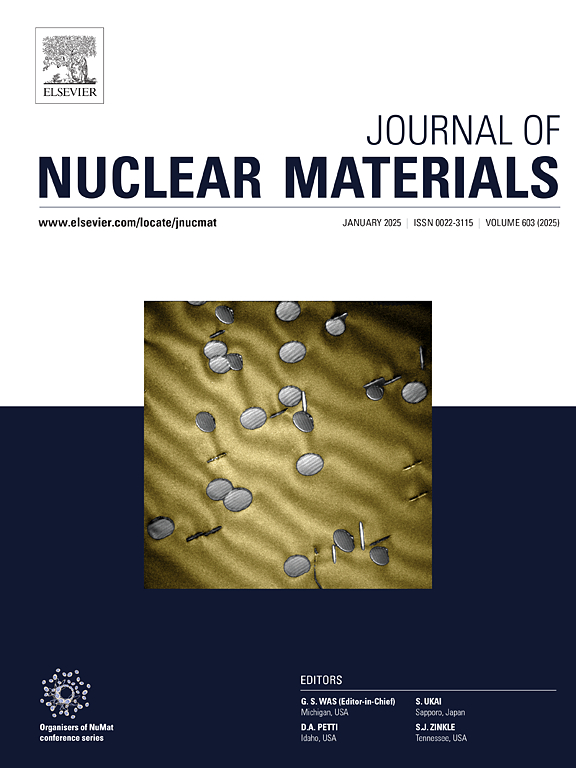Effect of microstructural features on tensile properties of β-Quenched Zr-2.5 %Nb alloy
IF 3.2
2区 工程技术
Q3 MATERIALS SCIENCE, MULTIDISCIPLINARY
引用次数: 0
Abstract
Zr-2.5 %Nb alloy in the cold-worked and stress-relieved (CWSR) condition is used as pressure tube (PT) material in Pressurized Heavy Water Reactors (PHWRs) with a design life of 30 years. To enhance in-reactor performance, an alternative fabrication route involving heat treatment is being explored for Indian PHWRs. For the development of heat-treated pressure tubes, it is essential to optimize process parameters to achieve the desired microstructure and texture. Among microstructural factors, prior β-grain size is crucial in determining the mechanical properties of the material. In this study, Zr-2.5 %Nb alloy specimens were exposed to varying temperatures within the β-phase region for different soaking times. Rapid heating and quenching techniques were employed to ensure the formation of a random texture. The prior β-grain size was assessed using optical microscopy, while the martensitic lath structure was characterized through electron backscatter diffraction (EBSD). The tensile properties of the heat-treated specimens were evaluated at room temperature. The study tracked the evolution of prior β-grain size over time to identify different stages of grain growth. This work investigates the influence of prior β-grain size, martensitic lath structure, and dislocation density on the tensile properties of the β-quenched Zr-2.5 %Nb alloy.
组织特征对β淬火zr - 2.5% Nb合金拉伸性能的影响
在设计寿命为30年的重水堆(PHWRs)中,采用冷加工和去应力(CWSR)条件下的zr - 2.5% Nb合金作为压力管材料。为了提高堆内性能,印度正在探索一种涉及热处理的替代制造路线。为了开发热处理压力管,必须优化工艺参数以获得理想的组织和织构。在微观组织因素中,β晶粒尺寸是决定材料力学性能的关键因素。在本研究中,将zr - 2.5% Nb合金试样在β相区不同温度下浸泡不同时间。采用快速加热和淬火技术,以确保随机织构的形成。利用光学显微镜评估了β晶粒的先验尺寸,利用电子背散射衍射(EBSD)对马氏体板条结构进行了表征。在室温下对热处理试样的拉伸性能进行了评价。该研究追踪了先前β-晶粒尺寸随时间的演变,以确定晶粒生长的不同阶段。本文研究了β-晶粒尺寸、马氏体板条组织和位错密度对β-淬火zr - 2.5% Nb合金拉伸性能的影响。
本文章由计算机程序翻译,如有差异,请以英文原文为准。
求助全文
约1分钟内获得全文
求助全文
来源期刊

Journal of Nuclear Materials
工程技术-材料科学:综合
CiteScore
5.70
自引率
25.80%
发文量
601
审稿时长
63 days
期刊介绍:
The Journal of Nuclear Materials publishes high quality papers in materials research for nuclear applications, primarily fission reactors, fusion reactors, and similar environments including radiation areas of charged particle accelerators. Both original research and critical review papers covering experimental, theoretical, and computational aspects of either fundamental or applied nature are welcome.
The breadth of the field is such that a wide range of processes and properties in the field of materials science and engineering is of interest to the readership, spanning atom-scale processes, microstructures, thermodynamics, mechanical properties, physical properties, and corrosion, for example.
Topics covered by JNM
Fission reactor materials, including fuels, cladding, core structures, pressure vessels, coolant interactions with materials, moderator and control components, fission product behavior.
Materials aspects of the entire fuel cycle.
Materials aspects of the actinides and their compounds.
Performance of nuclear waste materials; materials aspects of the immobilization of wastes.
Fusion reactor materials, including first walls, blankets, insulators and magnets.
Neutron and charged particle radiation effects in materials, including defects, transmutations, microstructures, phase changes and macroscopic properties.
Interaction of plasmas, ion beams, electron beams and electromagnetic radiation with materials relevant to nuclear systems.
 求助内容:
求助内容: 应助结果提醒方式:
应助结果提醒方式:


